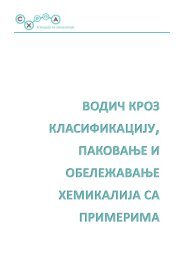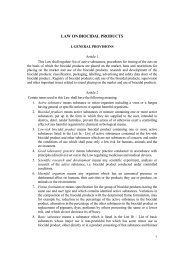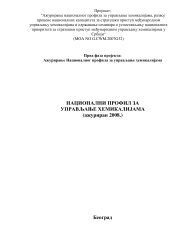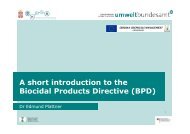GHS (CLP/GHS system) IN PRACTICE - Agencija za hemikalije
GHS (CLP/GHS system) IN PRACTICE - Agencija za hemikalije
GHS (CLP/GHS system) IN PRACTICE - Agencija za hemikalije
You also want an ePaper? Increase the reach of your titles
YUMPU automatically turns print PDFs into web optimized ePapers that Google loves.
On the ECHA's website is also an online tool (“<strong>GHS</strong> converter”) in German and English language that helps SMEsto familiarise themselves with <strong>GHS</strong>/<strong>CLP</strong> is provided by Berufsgenossenschaft Rohstoffe und chemische Industrie(BG RCI). You can also find the tool on their website: http://www.gischem.de/ghs/index.htm?client_locale=EN.This tool has not been validated at the EU level!4.5.3 EU FAQ regarding <strong>CLP</strong>On the ECHA's website http://echa.europa.eu/clp/clp_help_en.asp, are also following useful documents:• Questions and Answers Document: this document contains questions and answers introducing the EU <strong>CLP</strong>Regulation. The document focuses on background information and on general features and procedures of the<strong>CLP</strong> Regulation;• Frequently Asked Questions: the frequently asked questions have been agreed by and between the EUnational <strong>CLP</strong> helpdesks, representatives of the European Commission and European Chemicals Agency(ECHA). They are one of the results of the cooperation of the EU national helpdesks in the context of Help Net.The FAQs they try to provide practical and technical advice for the application of the rules of <strong>CLP</strong>4.5.4 Serbian helpdeskThe text will be provided only in Serbian language by Serbian colleagues!5. HOW SHALL I CLASSIFY?5.1 What is a classification? And what is a harmonised classification?Classification is the starting point for ha<strong>za</strong>rd communication. It involves the identification of the intrinsicha<strong>za</strong>rdous propertie(s) of a chemical or mixture by assigning a category of ha<strong>za</strong>rd/danger using defined criteria.The <strong>CLP</strong>/<strong>GHS</strong> Rulebook is designed to be consistent and transparent. It draws a clear distinction between classesand categories in order to allow for "self classification". For many ha<strong>za</strong>rds a decision tree approach is provided inthe <strong>CLP</strong>/<strong>GHS</strong> Rulebook. For several ha<strong>za</strong>rds the <strong>GHS</strong> criteria are semi-quantitative or qualitative. Expert judgmentmay be required to interpret these data.Chemicals to be placed on the Serbian market have to be classified using one of the following approaches:• Use of harmonised classifications;The List of Classified Substances (“Official Gazette RS” No. 82/10) contains substances which shall normally besubject to harmonised classification and labeling for following ha<strong>za</strong>rdous properties:• respiratory sensitisation, category 1, or/and• germ cell mutagenicity, category 1A, 1B or 2 , or/and• carcinogenicity, category 1A, 1B or 2, or/and• reproductive toxicity, category 1A, 1B or 2 .Active substances of plant protection products or biocidal products involved in the List of Classified Substancesshall normally be subject to harmonised classification and labelling for all ha<strong>za</strong>rd classes or differentiations.The use of a harmonised classification from the List of Classified Substances is mandatory for manufacturers,importers and downstream users.• Self-classification by application of the criteria:Self-classification is the supplier’s decision on a particular classification. For substances, it must be done for thoseha<strong>za</strong>rds where no harmonised classification exists. For mixtures, self-classification has always to be done. Theclassification criteria are set out in Part 2-5 of Annex I to <strong>CLP</strong>/<strong>GHS</strong> Rulebook. Mixtures will always have to be self-18
















